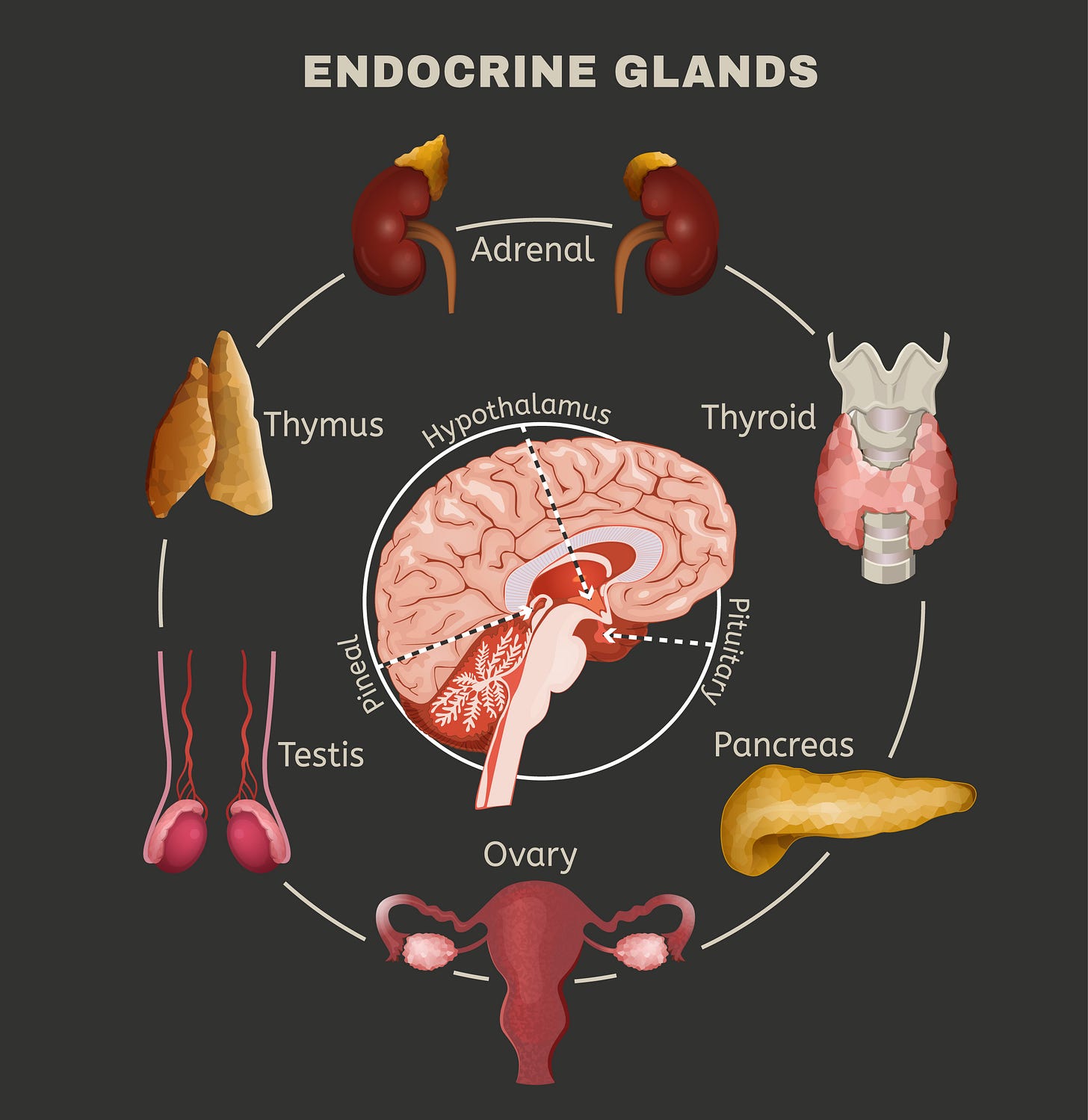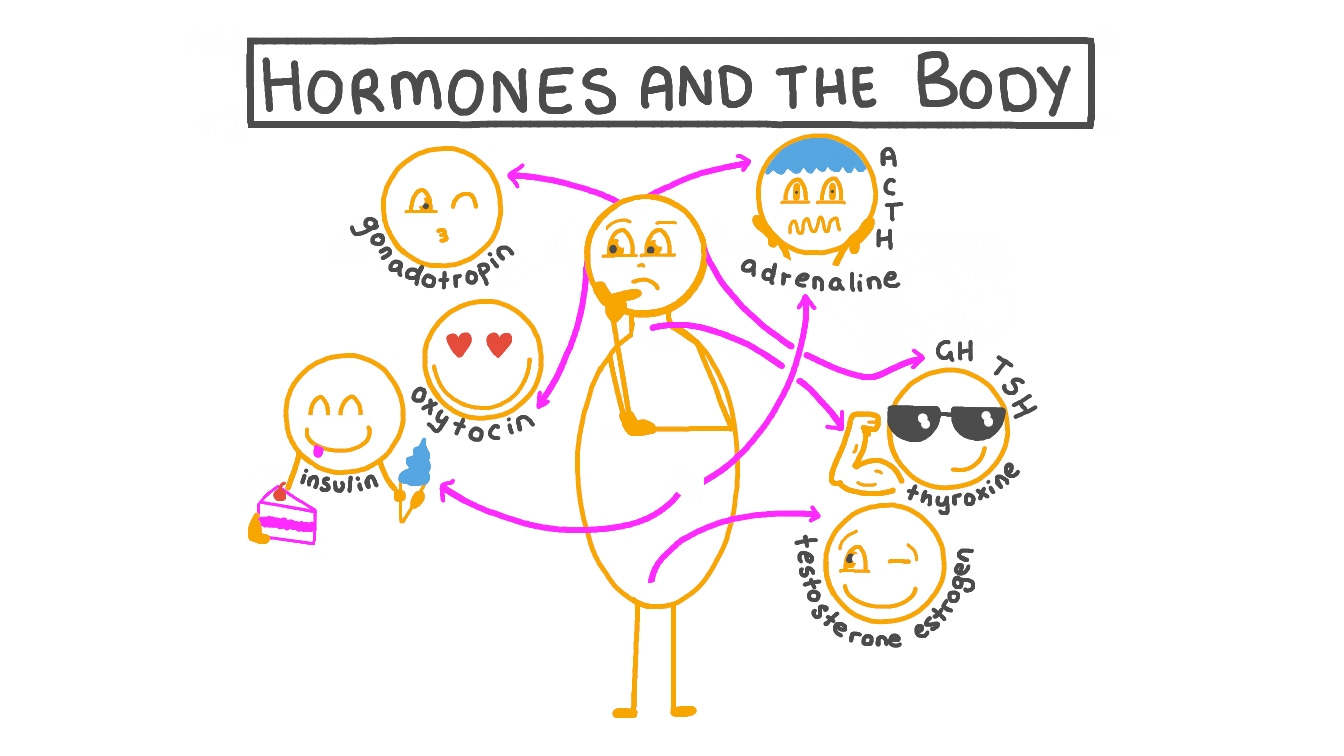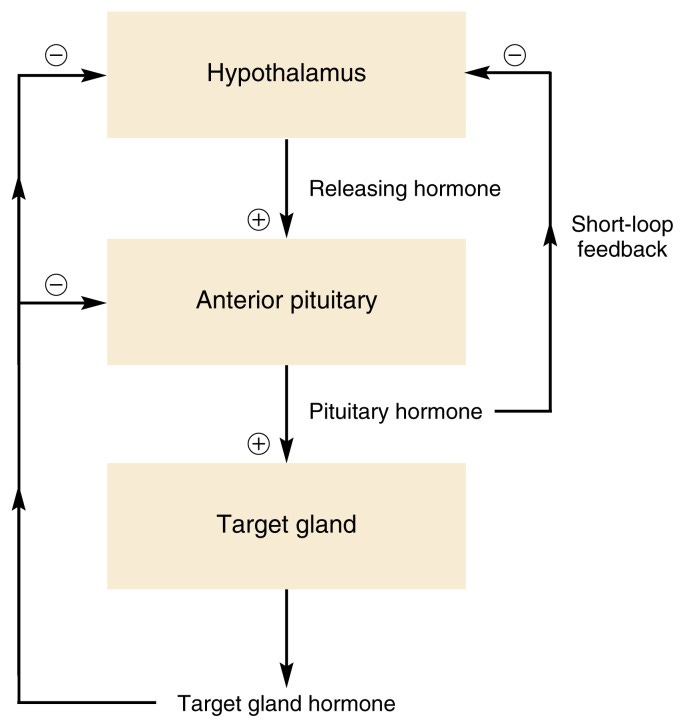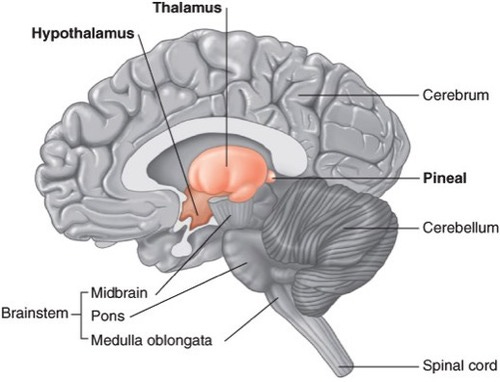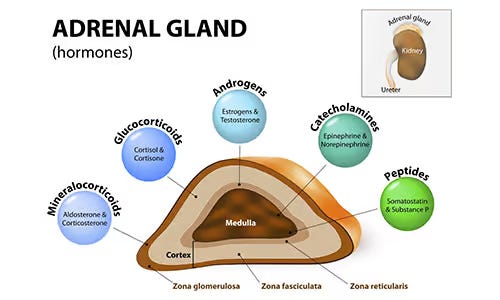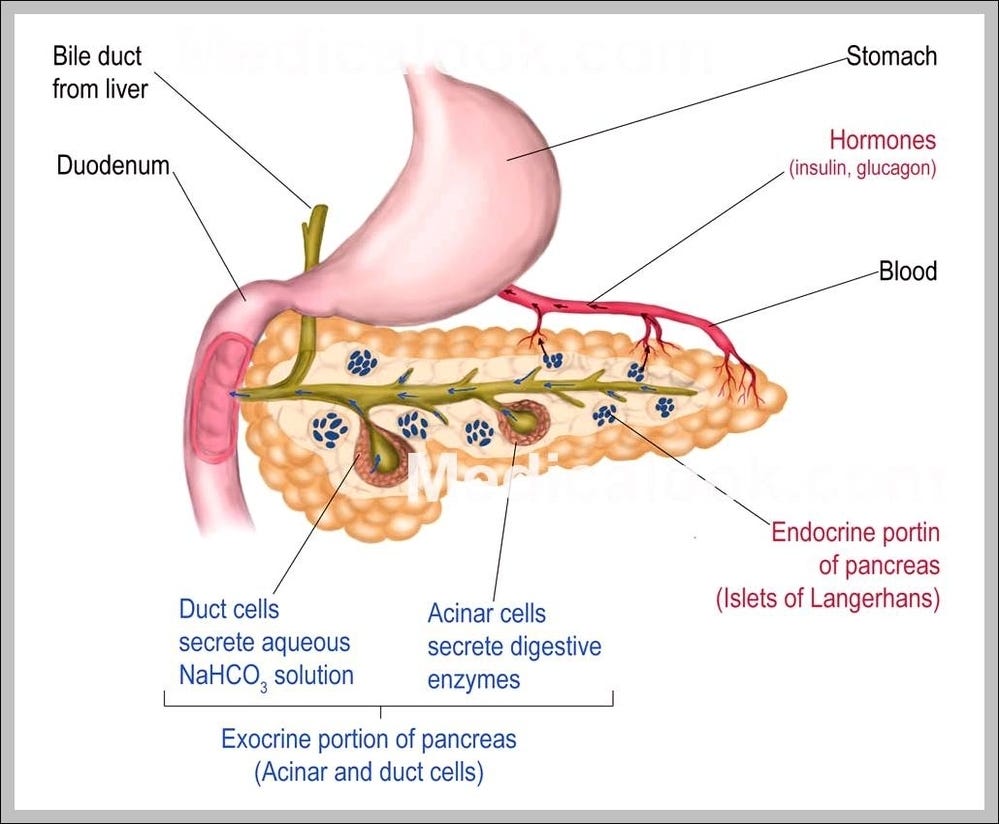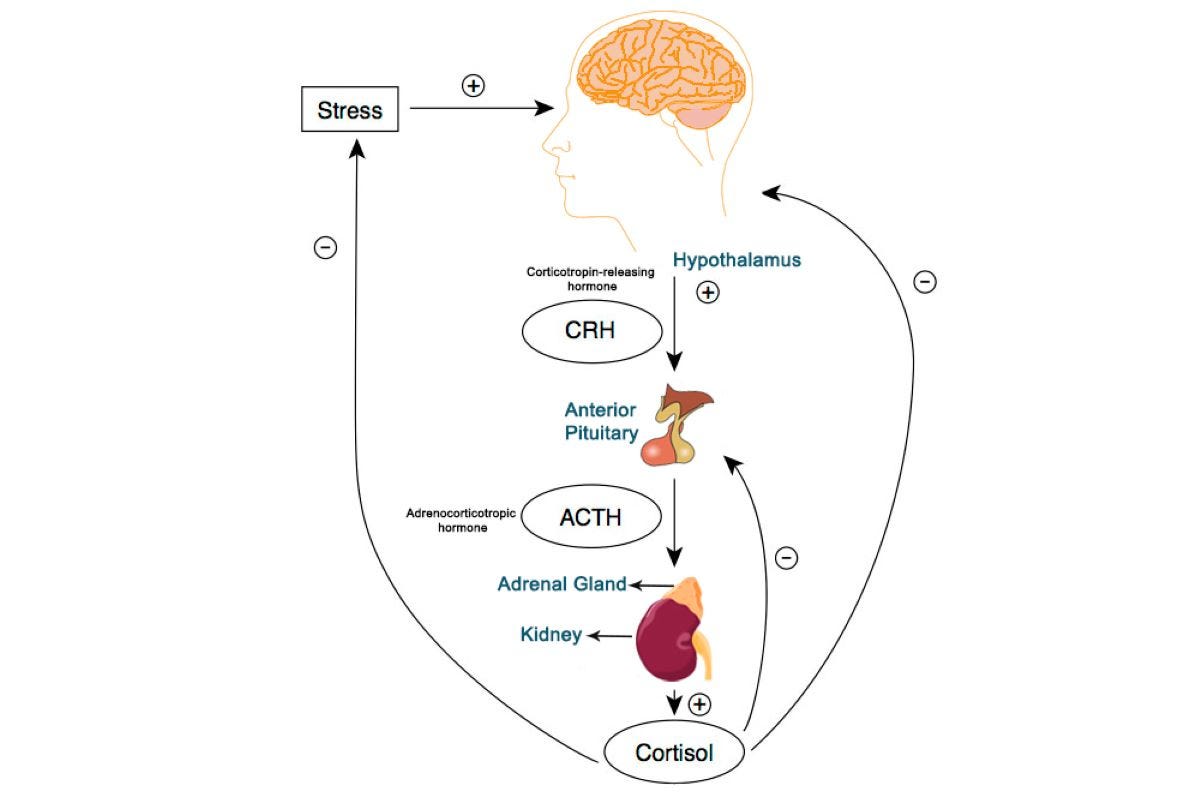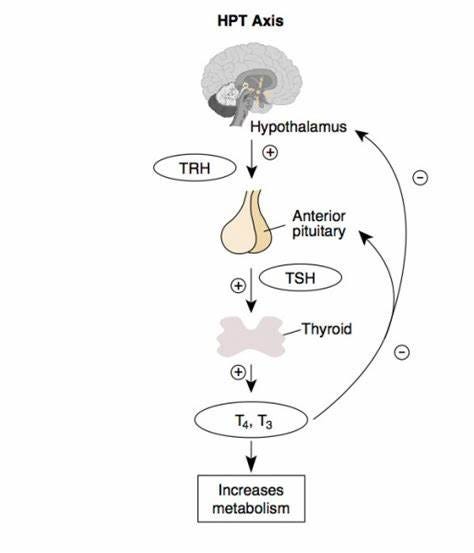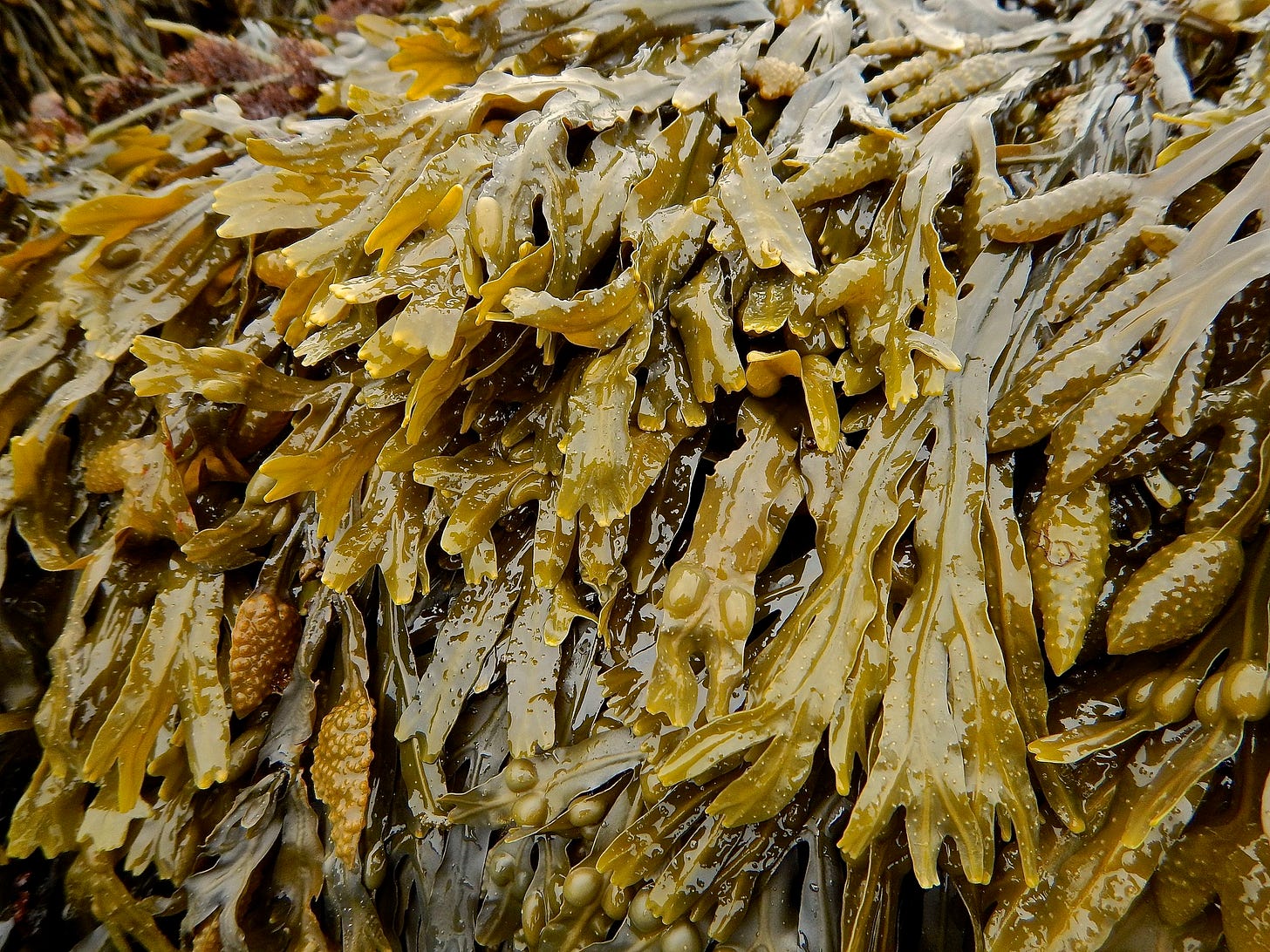The Endocrine System: How It Works, Why It Matters to Herbalists, and How It Influences the Entire Body
what every herbalist should know about hormones, endocrine balance, and the plants that can support resilience.
There’s a trend that’s been gnawing at me lately. You’ve probably seen it too — the surge of “hormone coaches” and self-declared “cortisol specialists” dominating your social media feed with claims that they’ve cracked the code on your fatigue, your period problems, your mood swings, your metabolism.
Their solutions? Often wrapped in shiny infographics and sold through overpriced protocols or a six-week course that promises to make them an “expert.”
Now, if you know my story, you know this: I completed medical school. I studied the biochemistry, the physiology, the feedback loops, the wild intricacy of the human body, in and out, for years. And while I walked away from a career in conventional medicine to follow my calling in herbalism, I didn’t forget what that training gave me. I’m here because I believe plants hold wisdom. But I’m also here because I know how easy it is to get misled when you're exhausted, frustrated, and looking for real answers.
So here’s my (maybe spicy) take:
Do I think mainstream medicine gets everything right when it comes to hormone health? Absolutely not. In fact, I believe that system often patches symptoms without addressing the root cause — and ignores modalities that have supported human health for centuries.
But do I also believe that a crash course and a curated social media aesthetic are enough to position someone as a hormonal authority? No. No ma’am. No sir. Get that out of here.
There’s nuance to this conversation, and we deserve to have it. Yes, the medical system is flawed. Yes, herbalism was pushed aside for profit and power. But we cannot replace one rigid, reductionist system with another one dressed in soft colors and anecdotal science. Especially when real people, often vulnerable people, are entrusting their health to whoever shows up first on their feed.
So that’s why we’re here.
To talk about the endocrine system honestly.
To understand what these glands actually do, how hormones move and respond, what balance really looks like, and how herbalism can offer meaningful support. Whether you’re working with a doctor, an herbalist, or simply trying to understand your own body better — this article is for you.
Let’s pull back the curtain, ditch the gimmicks, and get into the real medicine.
If this all feels like a lot to take in, don’t worry. Members of The Buffalo Herbalist Community will receive a full set of resources to help make this content easier to grasp and apply.
This includes:
A Hormone Axis Cheat Sheet to help you visualize how these systems connect and which herbs may offer support based on what we do know
Detailed monographs in PDF form for several herbs mentioned in this article, including Liquorice, Borage, Bugleweed, and Bladderwrack, covering their history, energetics, indications, safety, and preparation
A Hormone Glossary featuring full hormone names and their functions
An Endocrine Gland Glossary outlining the role of each gland in the system
These resources are designed to help you review at your own pace, deepen your understanding, and make informed, grounded choices in your herbal path.
What Are Hormones, Really?
Let’s start with the basics. Not the buzzwords.
hormones and the body
Hormones are chemical messengers. They’re made by glands scattered throughout your body and released into your bloodstream to travel wherever they’re needed. Think of them like microscopic letters being mailed out from your internal post office. Only the intended recipients, your body’s target cells ,know how to read them.
And when they do?
Whole-body responses unfold: mood shifts, energy surges, menstrual cycles, hunger cues, growth spurts, sleep-wake rhythms, metabolic recalibrations. All orchestrated by these unseen messengers.
We tend to treat “hormones” like a monolith, something that’s either “balanced” or “out of whack.”
But the truth is, there are many types of hormones with very different jobs. Some, like insulin, regulate blood sugar. Others, like cortisol, manage your stress response. Estrogen and testosterone guide reproductive health, while thyroid hormones control your metabolic engine.
And behind many of these is a complex web of checks and balances, a cascade of signals often starting in the brain, where the hypothalamus and pituitary gland act as command central.
Let me put it another way.
If your body were a kingdom, the hypothalamus would be the diplomat gathering intel, the pituitary the queen issuing orders, and the target organs like your adrenals, thyroid, ovaries, or testes the skilled workers who carry out those commands by releasing their own specialized hormones. Because this kingdom values stability, it runs on a tight system of feedback loops, like internal surveillance that says, “Hey, we’ve got enough of that. You can ease up now.”
Hormone feedback loop
These hormonal messages aren’t fast like nerve impulses. They’re slower, steadier, and longer-lasting. That’s part of what makes endocrine dysfunction so tricky. It can sneak up on you. It can whisper, not scream. But it can also speak loudly through irregular periods, burnout, hair loss, sleep issues, or persistent fatigue.
So before we dive into specific glands and herbal allies, I want you to understand this:
Hormones are not your enemy. They’re not broken because you feel tired, or anxious, or bloated. They’re responding to something. And sometimes, that “something” isn’t solved with a supplement or a cleanse, but with a deeper understanding of what your body is trying to say.
Let’s keep listening.
The Hypothalamus: Where It All Begins
Tucked deep within your brain, the hypothalamus may be small, but its influence stretches across nearly every system in the body. It helps regulate hunger and thirst, body temperature, blood pressure, sex drive, circadian rhythm, and even emotional responses like fear, anger, and pleasure. It’s also the crucial bridge between your nervous system and your endocrine system. This is where thought, feeling, and physiology meet.
What makes the hypothalamus special is that it’s technically part of the brain, more specifically part of the central nervous system, and yet it functions like an endocrine gland. The hormones it releases aren’t made by traditional endocrine tissues but by neurons. Yes, nerve cells. Which means your stress, your senses, your sleep, and your relationships all influence what this tiny region is doing.
Because of this, the hypothalamus doesn’t just respond to what’s happening inside your body. It’s also tuned into what’s happening around you. Light exposure, ambient temperature, emotional stress, pain, hunger cues, and even subtle social signals from others all inform its activity. Your hypothalamus translates these environmental and internal signals into hormonal messages that can initiate far-reaching effects throughout your body.
It does this by sending those chemical messages through a dedicated system of blood vessels called the hypothalamic-pituitary portal system, which connects directly to the pituitary gland. The hormones it releases are often referred to as releasing or inhibiting hormones because they either stimulate or suppress the production of other hormones in the pituitary.
Here’s a quick overview of the major hormones the hypothalamus produces:
Corticotropin-releasing hormone (CRH): Helps regulate your stress response, metabolism, immune function, and fluid balance.
Gonadotropin-releasing hormone (GnRH): Controls reproductive function, including menstruation, ovulation, and lactation.
Thyrotropin-releasing hormone (TRH): Regulates your thyroid function and also plays a role in milk production.
Growth hormone-releasing hormone (GHRH): Stimulates growth and cellular repair, especially during childhood and adolescence.
Somatostatin: The brake pedal to GHRH’s gas. It inhibits growth hormone and modulates digestive processes.
Dopamine: Known mostly as a neurotransmitter, but here, it acts as a hormone too. One of its roles is to prevent milk production until it's needed postpartum.
So, when we talk about endocrine health, we have to start here. This is the hypothalamus. It’s where thoughts become hormones and where your perception of the world can directly influence your biology.
Up next, we’ll move into the pituitary gland. Often called the “master gland,” it carries out the hypothalamus’s orders and coordinates the rest of your endocrine system.
The Pituitary Gland: The Master That Takes Orders
Notice how the hormones from the hypothalamus are all called “releasing” hormones? That’s because they’re not the final messengers. They’re like carefully crafted memos sent down to the next in command — the pituitary gland — which then tells the rest of the body what to do.
Sometimes referred to as the “master gland,” the pituitary is a marble-sized structure nestled just beneath the hypothalamus. Despite its size, this gland holds enormous power over your hormonal landscape. But it doesn’t act alone. It takes its cues directly from the hypothalamus through a dedicated communication pathway called the hypothalamic-pituitary portal system.
The pituitary has two main parts: the anterior pituitary, which produces and releases several hormones, and the posterior pituitary, which stores and secretes hormones made in the hypothalamus.
Let’s break them down.
Pitutary anatomical location
The Anterior Pituitary: Messenger of Messengers
The anterior pituitary is the more active half of the gland. It produces several key hormones that either: (Anterior refers to the front of the body or structure - so here we are talking about the front portion of the pituitary gland)
Instruct other endocrine glands to produce their own hormones
Or directly influence target organs and tissues
Here are the major players:
ACTH (Adrenocorticotropic Hormone): Stimulates the adrenal glands to produce cortisol, your primary stress hormone
TSH (Thyroid-Stimulating Hormone): Signals the thyroid to produce hormones that regulate metabolism
LH & FSH (Luteinizing and Follicle-Stimulating Hormones): Regulate reproductive hormones, ovulation, and sperm production
GH (Growth Hormone): Supports tissue growth, cellular repair, and metabolism
Prolactin: Stimulates milk production after childbirth
Let’s zoom in on the two that act directly on the body rather than through other glands.
Growth Hormone (GH)
Growth hormone is the most abundant hormone produced by the pituitary. While it helps children grow, GH also plays a major role in adults. It supports muscle tone, skin elasticity, energy metabolism, and even the aging process.
GH helps:
Stimulate bone and tissue growth
Support connective tissue and muscle mass
Encourage fat breakdown for energy
Raise blood sugar (opposing insulin)
Promote cellular repair and regeneration
It works directly on some tissues and indirectly on others by triggering the liver and kidneys to produce IGF-1 (Insulin-like Growth Factor 1). IGF-1 helps stimulate DNA synthesis and cell division in the growth process.
GH is tightly regulated by the hypothalamus through two opposing hormones: GHRH, which stimulates its release, and somatostatin, which inhibits it. Deep sleep, exercise, and fasting can all increase GH. Alcohol, however, suppresses it — especially in adolescents, when GH is crucial for development.
Prolactin
Prolactin is best known for initiating and maintaining milk production in breastfeeding mothers. Its release is naturally inhibited most of the time by dopamine, but that inhibition is lifted during pregnancy and postpartum. Prolactin is released in response to infant suckling and also increases during pregnancy due to rising estrogen levels.
In men, its role is less clear. However, high prolactin levels have been linked to decreased libido and sexual dysfunction. Alcohol can interfere with prolactin as well as oxytocin, which is essential for milk ejection.
The Posterior Pituitary: Storage and Release
Unlike the anterior lobe, the posterior pituitary doesn’t make hormones. It simply stores and releases two that are made in the hypothalamus:
Vasopressin (AVP): Helps regulate fluid balance by telling the kidneys to reabsorb water. It’s influenced by sodium levels, blood volume, and pressure. Alcohol inhibits vasopressin, which explains why drinking leads to more frequent urination.
Oxytocin: Triggers uterine contractions during labor and causes milk to be released while breastfeeding. It’s also associated with emotional bonding, touch, and trust.
Both hormones are produced in the hypothalamus, then travel down nerve fibers to be stored in the posterior pituitary until needed.
Remember if this feels like a lot, don’t worry — I’ve got you. For members of The Buffalo Herbalist Community, I’ll be posting a downloadable Hormone Cheat Sheet to help make all of this easier to digest. It’s designed to help you connect the dots between glands, hormones, and functions at a glance.
Next, we’ll follow the signals further into the body — exploring the thyroid, adrenal glands, and how all of this ties into energy, stress, and metabolism. And of course, we’ll talk herbs
The Adrenal Glands: Stress, Salt, and Survival
Now that we’ve covered the pituitary, let’s follow its signals to one of its most important targets — the adrenal glands.
You have two adrenal glands, each one sitting like a little cap on top of your kidneys. Don’t let their size fool you. These tiny organs play a huge role in how your body handles stress, energy, inflammation, and fluid balance.
Each adrenal gland is made up of two distinct parts: the adrenal cortex (the outer layer) and the adrenal medulla (the inner core). And each layer has its own job.
The Cortex: Cortisol, Aldosterone, and a Bit of Testosterone
The adrenal cortex is in charge of making steroid hormones — mainly cortisol (a glucocorticoid) and aldosterone (a mineralocorticoid). (The ending ‘corticoid’ can give you a hint of being a steroid hormone)
It also produces a small amount of sex hormones, though nowhere near what your ovaries or testes make.
Let’s start with cortisol.
Cortisol: The “Stress Hormone” — But So Much More
Cortisol gets a bad rap, but it’s not your enemy. You need it to survive. It helps your body manage blood sugar, regulate metabolism, control inflammation, and respond to stress.
It’s released in a daily rhythm (your circadian rhythm) with a spike in the early morning to help you wake up and get moving. But it also surges in response to physical, emotional, or environmental stress.
Here’s what cortisol does:
Raises blood sugar by telling the liver to make more glucose
Helps store that glucose in the form of glycogen
Limits glucose uptake in muscles and fat (counteracting insulin)
Breaks down proteins and fats to use as energy sources
Suppresses inflammation and modulates immune responses
Sounds useful, right? It is — until there’s too much of it, for too long. Chronic stress can keep cortisol levels elevated, which can lead to fatigue, poor sleep, belly weight gain, mood shifts, and immune suppression. On the flip side, if your body can’t make enough cortisol, even minor stressors can become life-threatening. This is why cortisol is essential, not optional.
And maybe the complexity of this hormone explains why I take issue with Instagram’s self-declared “cortisol specialists.” Cortisol isn’t something you can hack or fix with a trending protocol. It’s part of a finely tuned system your body works tirelessly to regulate. Handing that over to someone who isn’t truly trained — but is capitalizing on vulnerability and buzzwords — isn’t just misleading. It’s exploitative.
Aldosterone: The Unsung Hero of Electrolyte Balance
Aldosterone doesn’t get as much attention as cortisol, but it plays a vital role in maintaining fluid balance and blood pressure. It tells your kidneys to hold onto sodium and get rid of potassium, which in turn affects how much water your body retains. This hormone helps keep your blood pressure stable and prevents you from losing too much sodium through sweat or urine.
Unlike cortisol, aldosterone isn’t controlled by the pituitary. Instead, it’s regulated by the renin-angiotensin system — a feedback loop between your kidneys, liver, and blood vessels that responds to fluid volume and electrolyte levels. For example, when you’re dehydrated, aldosterone ramps up to help your body retain more water and sodium. It’s especially important in hot climates or during times of intense sweating.
The Medulla: Adrenaline and Noradrenaline
The adrenal medulla sits at the core of each gland and is responsible for your immediate “fight or flight” response.
It produces epinephrine (adrenaline) and norepinephrine (noradrenaline) — hormones that trigger a rapid increase in heart rate, blood pressure, respiratory rate, and blood glucose levels. These hormones help you run, fight, or respond to danger in the moment. They’re also part of the sympathetic nervous system, making the adrenal medulla a bit of a hybrid between the nervous and endocrine worlds.
The adrenal glands are often at the center of conversations about burnout, fatigue, and hormone imbalance. While the phrase “adrenal fatigue” gets tossed around a lot, it’s not a medically recognized condition. (It is an Agy-recognized condition) What is real, however, is HPA axis dysregulation, a breakdown in communication between the hypothalamus, pituitary, and adrenal glands, often caused by chronic stress, poor sleep, blood sugar instability, or trauma.
The Gonads: Estrogen, Testosterone, and the Hormones of Reproduction
We tend to think of the gonads, ovaries and testes, purely in terms of reproduction. But their role in the endocrine system goes far beyond sex and fertility. These organs don’t just make eggs and sperm. They produce powerful steroid hormones that shape everything from puberty to bone health to cardiovascular function.
There are three main categories of sex hormones:
Estrogens (like estradiol): Feminizing effects, menstrual cycles, pregnancy, bone protection
Progestogens (like progesterone): Prepares and maintains the uterus for pregnancy
Androgens (like testosterone): Masculinizing effects, libido, muscle growth, sperm production
Let’s take a closer look.
Estrogens
Estradiol is the star of the estrogen family. Produced mostly in the ovaries, it’s also made in the corpus luteum, placenta, adrenal glands, and, in smaller amounts, converted from androgens in fat and skin cells (especially in men and postmenopausal women).
Estrogen does more than regulate the menstrual cycle. It shapes the female body during puberty, supports pregnancy, influences libido, and protects against bone loss and cardiovascular issues. As estrogen declines during menopause, symptoms like hot flashes, insomnia, irritability, and osteoporosis often emerge.
Interestingly, moderate alcohol intake has been shown to raise estrogen levels, but studies on whether that’s helpful or harmful remain mixed.
A Note on Phytoestrogens
Despite the name, phytoestrogens are not actual estrogens. These are plant-based compounds that resemble estrogen in structure and can bind to estrogen receptors in the body. Depending on the hormonal environment, they may either gently mimic estrogen or block its effects.
You’ll find phytoestrogens in a number of commonly used herbs, including:
Red Clover (Trifolium pratense)
Licorice Root (Glycyrrhiza glabra)
Hops (Humulus lupulus)
Alfalfa (Medicago sativa)
These herbs can be incredibly helpful for certain people, especially during times of hormonal transition like menopause.
However, I offer this note of caution: if you’re already dealing with signs of estrogen excess such as heavy periods, PMS, fibrocystic breasts, or cycle-related migraines, phytoestrogens can sometimes increase those symptoms.
This is something I’ve experienced firsthand. Even “gentle” herbs like red clover can push the body further out of balance if underlying hormonal patterns aren’t addressed holistically.
So yes, phytoestrogens have a place. But that place depends on your body, your cycle, and your current hormonal landscape. As always, context matters.

Progestogens
Progesterone is produced in the ovaries during the second half of the menstrual cycle and later by the placenta in pregnancy. Its job is to make the uterus ready for implantation and support early pregnancy. It also works with estrogen to prepare the breasts for lactation. Beyond reproduction, progesterone has calming effects on the nervous system and may support sleep and anxiety regulation.
Androgens
Testosterone, the primary male sex hormone, is made mostly in the testes but also in smaller amounts by the adrenal glands and ovaries. It ensures the development of male genitalia in utero, initiates puberty, deepens the voice, increases muscle mass, and fuels libido and sexual function throughout life.
Androgens are anabolic, meaning they help build protein and increase muscle. While testosterone does decline with age, the drop is generally gradual — not as sudden or sharp as estrogen in menopause.
The Thyroid: Your Metabolic Thermostat
The thyroid gland sits at the base of your neck, shaped like a butterfly, and quietly governs your body’s metabolic rate. It produces T4 (thyroxine) and T3 (triiodothyronine), hormones made from the amino acid tyrosine and the mineral iodine. T4 is the storage form. T3 is the active form. Most of your T4 is converted to T3 in the liver and kidneys.
Thyroid hormone helps:
Regulate energy production and temperature control
Support healthy development of the brain and nervous system
Maintain heart rate, digestion, and skin health
Promote normal growth and bone development
It also works in tandem with growth hormone during childhood and adolescence.
Another hormone made in the thyroid, calcitonin, helps regulate calcium levels by reducing bone breakdown and preventing calcium loss through the kidneys. It works in opposition to parathyroid hormone (PTH), which we’ll cover next.
The Parathyroid Glands: Tiny But Mighty
Behind the thyroid sit four tiny glands — the parathyroids — responsible for producing PTH (parathyroid hormone). PTH’s job is to increase calcium levels in the blood, which is critical for nerve signaling, muscle contraction, and bone structure.
Here’s how it works:
It pulls calcium from bones when blood levels are too low
Increases calcium reabsorption in the kidneys
Boosts calcium absorption from food via vitamin D activation
Reduces phosphate levels to maintain mineral balance
PTH is regulated directly by blood calcium levels, not the pituitary, making it a feedback loop all its own. When calcium drops, PTH rises. When calcium levels normalize, PTH steps back.
The Pancreas: Balancing Blood Sugar
Your pancreas does double duty as it’s both an exocrine and endocrine organ. The exocrine pancreas makes digestive enzymes. But the part we’re focusing on here is the Islets of Langerhans, which produce two vital hormones: insulin and glucagon.
Insulin
Made by beta cells, insulin is the only hormone that lowers blood sugar. It helps move glucose into cells to be used as energy or stored as glycogen. It also promotes fat and protein synthesis and slows down glucose production in the liver.
Insulin helps:
Clear glucose from the blood into liver, muscle, and fat cells
Store energy in the form of glycogen and fat
Promote protein building in muscle
Inhibit glucose production from amino acids and fats (gluconeogenesis)
When this system doesn’t work, due to insulin resistance or deficiency, blood sugar climbs, leading to metabolic dysfunction and eventually diabetes.
Glucagon
Produced by alpha cells, glucagon does the opposite of insulin. It raises blood sugar by telling the liver to break down glycogen and start producing glucose from other materials. Glucagon is essential during fasting, exercise, or low-carb diets.
Together, insulin and glucagon create a delicate balance that keeps your blood sugar stable throughout the day. When this relationship breaks down, symptoms of fatigue, irritability, and serious metabolic conditions can emerge.
The Axes That Keep It All in Sync: HPA, HPG, and HPT
By now, you’ve seen how each gland has its own set of responsibilities and hormones. But what makes the endocrine system so remarkable is how connected it all is. Many of the body’s most vital functions — stress, reproduction, and metabolism — are regulated by hormonal cascades that start in the brain and ripple outward. These feedback loops are called axes, and they help the body adjust, adapt, and stay in balance.
Some hormones, like insulin or parathyroid hormone, respond directly to what’s happening in the blood — glucose goes up, insulin kicks in. Calcium drops, PTH rises. But most hormones, especially the ones involved in deeper, long-term processes like stress and fertility, rely on this brain-to-gland chain of command.
Let’s break down the three major endocrine axes:
The HPA Axis (Stress + Survival)
This is your hypothalamic-pituitary-adrenal axis — the hormonal highway behind your stress response.
The hypothalamus releases CRH (corticotropin-releasing hormone)
CRH tells the pituitary to release ACTH (adrenocorticotropic hormone)
ACTH stimulates the adrenals to release cortisol
Cortisol helps you respond to stress by raising blood sugar, increasing energy availability, and modulating inflammation. Once cortisol levels rise, it loops back to tell the hypothalamus and pituitary to calm down — a classic negative feedback loop.
When this system works well, it helps you bounce back from stress. But when it’s overstimulated (chronic stress, trauma, poor sleep), cortisol stays high and the system gets dysregulated. This can lead to burnout, immune imbalance, sleep issues, and mood shifts.
Too little cortisol? Addison’s disease.
Too much? Cushing’s syndrome.
Too much stress for too long? HPA axis dysfunction — and you’ll feel it.
Alcohol can activate the HPA axis, especially with chronic use. Some heavy drinkers even develop pseudo-Cushing’s symptoms, which often improve with sobriety.
The HPG Axis (Sex Hormones + Fertility)
The hypothalamic-pituitary-gonadal axis regulates estrogen, progesterone, and testosterone. It’s behind puberty, fertility, libido, and the reproductive cycles of both men and women.
The hypothalamus releases GnRH (gonadotropin-releasing hormone)
GnRH signals the pituitary to release LH and FSH
These stimulate the gonads — testes in men, ovaries in women
In men, LH prompts testosterone production in the testes. FSH works with testosterone to support sperm maturation.
In women, LH and FSH regulate the menstrual cycle, including ovulation and progesterone release from the corpus luteum.
This axis is unique in that it includes both negative and positive feedback. Estrogen usually suppresses LH and FSH, but just before ovulation it actually increases LH, triggering the release of the egg.
Alcohol can interfere with this axis too. In both men and women, excessive drinking has been linked to infertility, hormone imbalance, and menstrual irregularities.
The HPT Axis (Metabolism + Energy)
Last but not least, we have the hypothalamic-pituitary-thyroid axis — your body’s thermostat.
The hypothalamus releases TRH (thyrotropin-releasing hormone)
TRH signals the pituitary to release TSH (thyroid-stimulating hormone)
TSH activates the thyroid to produce T3 and T4
These thyroid hormones regulate metabolic rate, temperature, heart rate, and digestion. They also influence development, mood, and bone health.
Once enough thyroid hormone is circulating, the system slows itself down through, you guessed it, negative feedback.
In healthy people, alcohol doesn’t appear to significantly alter thyroid function. But in alcoholics or those in withdrawal, thyroid hormone regulation can become impaired — sometimes due to changes in dopamine, which also influences prolactin and TSH release.
There’s even emerging research that blunted TSH responses might be a marker of vulnerability to alcoholism, though we don’t fully understand the mechanism yet.
Integration Over Isolation
Your endocrine system isn’t just a collection of glands doing their own thing. It’s a network. A conversation. A delicate balance of signals moving from brain to body and back again, regulating everything from blood sugar to mood to reproductive health.
As we’ve seen, some hormones respond directly to what’s happening in the blood. Others rely on intricate chains of command between the hypothalamus, pituitary, and peripheral glands. When you zoom out from the pancreas and parathyroids to the thyroid, adrenals, and gonads, it becomes clear just how many moving parts are involved.
Supporting the endocrine system is not simple.
There is no one herb or product that will “fix” your hormones. What we’re really supporting is a system of adaptive feedback that is influenced by stress, sleep, nutrition, relationships, environment, and emotional state.
The endocrine glands are central to all integration, coordination, and communication within the body. They also sit at the interface of mind, body, and emotion.
Long before science identified their physiological roles, many spiritual traditions described these centers as chakras or energetic power hubs. That ancient understanding of energy, intention, and inner alignment still resonates with many of us today.
Note: These are not the same “glands” we talked about in the lymphatic system. Those are lymph nodes, part of the immune system. You can read more about them here:
As clinical herbalist David Hoffmann reminds us, the activity of herbs on the endocrine glands, while real, is still not well understood from a scientific standpoint.
This opens the door to pseudoscience, with exaggerated claims that not only mislead but also dilute the real relevance of herbs in practice. That’s why this publication prioritizes transparency.
But that doesn’t mean we can’t support these pathways with herbs. We absolutely can. We just do so with humility, observation, and whole-body context.
A Few Trusted Herbal Allies for Endocrine Health
David Hoffmann offers a simple truth: a good way to ensure glandular health is to support overall health and vitality. This includes nourishing foods, rest, movement, and joy — supported by herbal alteratives, bitters, and tonics.
Below are a few plants that show promise in working gently with endocrine pathways.
For the Adrenal Glands and Stress:
Liquorice (Glycyrrhiza glabra): Adaptogenic, adrenal tonic, demulcent, anti-inflammatory. Especially helpful in adrenal exhaustion and conditions like Addison’s disease. Best used short-term and not recommended for those with high blood pressure.
Borage (Borago officinalis): Restorative to the adrenal cortex. Traditionally used after corticosteroid treatment or during recovery from stress. Also supports the nervous system and milk production in lactating mothers.
Barago officinalis
For the Thyroid:
Bugleweed (Lycopus europaeus): A specific for overactive thyroid, especially when there’s anxiety, palpitations, or tension in the chest and throat. Useful for hyperthyroidism with nervous origin.
Bladderwrack (Fucus vesiculosus): Rich in iodine and minerals, this seaweed supports underactive thyroid and metabolic sluggishness. Can aid with weight gain related to hypothyroid function and relieve joint inflammation.
Fucus vesiculosus
For the Pancreas and Blood Sugar:
Bitters in general (e.g., gentian, dandelion root, artichoke): Help stimulate digestive secretions and support the organs of metabolism, including the pancreas.
Goat’s Rue (Galega officinalis): Traditionally used to support insulin production and lactation, mentioned as a galactagogue with endocrine affinity. Must be used with care and professional guidance.

General Glandular Support:
Adaptogens like Ginseng and Siberian Ginseng (Eleutherococcus): Help the body adapt to stress, regulate the HPA axis, and build long-term resilience.
Tonic herbs like Nettles, Milky Oats, and Burdock: Offer mineral nourishment, gentle detoxification, and system-wide support without overstimulation.

Herbalism, at its heart, is about relationship, not control.
We aren’t here to dominate the body or override its signals, but to work in partnership with its intelligence.
While modern science still has a lot to uncover about how herbs interact with our endocrine glands, traditional herbal practice has long recognized the importance of nourishing resilience, supporting recovery, and gently working with the body’s innate rhythms. That’s exactly what many of these herbs offer—not a quick fix, but steady, grounded support.
You don’t need to memorize every hormone. You just need to start recognizing the patterns and trust that your body remembers how to heal when it’s supported with wisdom, care, and clarity.
That was a lot, but if you’ve made it this far, I hope you feel a little more connected to the beauty and complexity of your endocrine system.
Members of The Buffalo Herbalist Community get access to all the supplemental materials that accompany this post, including:
A printable Hormone Axis Cheat Sheet
Four detailed PDF herbal monographs (Liquorice, Borage, Bugleweed, and Bladderwrack)
A full Hormone Glossary with complete hormone names and their functions
An Endocrine Gland Glossary to help bring all the pieces together
You’ll find these materials available after the bibliography, along with a sneak peek image so free subscribers can preview what they look like. My hope is that it helps you feel more confident in your studies, more empowered in your body, and more grounded in the way you work with herbs.
If you found this article valuable, consider becoming a paid subscriber to support this work and gain access to even more in-depth tools like this one.
Next week, I’ll be releasing my recorded lecture on Medicinal Mushrooms. It’s a full presentation covering the science, energetics, folklore, and clinical relevance of mushrooms like Reishi, Lion’s Mane, and more. I can’t wait to share it with you.
Until then, take care of your glands, and take care of each other.
-Agy | The Buffalo Herbalist
Sneak peek of study materials:
If this looks like it would help you along in your herbal studies - become a member of The Buffalo Herbalist Community.
Bibliography
Chrousos, G. P. (2007). Organization and Integration of the endocrine System: The Arousal and sleep perspective. Sleep Medicine Clinics, 2(2), 125–145. https://doi.org/10.1016/j.jsmc.2007.04.004
Hiller-Sturmhöfel, S., & Bartke, A. (1998). The Endocrine System: An Overview. https://pmc.ncbi.nlm.nih.gov/articles/PMC6761896/#sec1
Hoffmann, D. (1988). The Herbal Handbook: A User’s Guide to Medical Herbalism. Inner Traditions.
Hoffmann, D. (2003). Medical Herbalism: The Science and Practice of Herbal Medicine. Healing Arts Press
Members of The Buffalo Herbalist Community - find your PDF study materials here:
Keep reading with a 7-day free trial
Subscribe to The Buffalo Herbalist to keep reading this post and get 7 days of free access to the full post archives.





